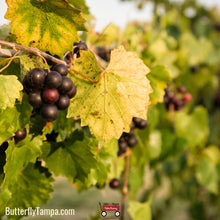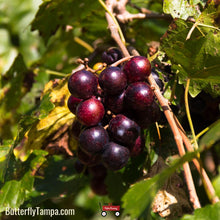The muscadine grape was the first native grape species to be cultivated in North America and has been extensively cultivated since the 16th century. It's common throughout Florida and can be found in wet to dry hammocks and scrub. Muscadine grapes thrive in summer heat. They can tolerate moderate to high drought, but plants growing in extremely dry soils may die during extended periods of drought. Muscadine berries may be bronze or dark purple or black when ripe. The berries are rich in polyphenols, fiber, and manganese, and are free of fat, sodium, and cholesterol. Muscadine grapes are used to make artisan wines, juice, and jelly. They're also an important food source for wildlife, including deer, black bears, raccoons, grouse, cardinals, mockingbirds, and cedar waxwings. Muscadine grapevines are tolerant of most insect pests and seldom are insecticides warranted. Natural pest managers usually keep aphids and other pests under control. This vine is a larval host for the Nessus Sphinx Moth and the Mournful Sphinx Moth. Flowers and fruits year-round in southern Florida.
/AC




